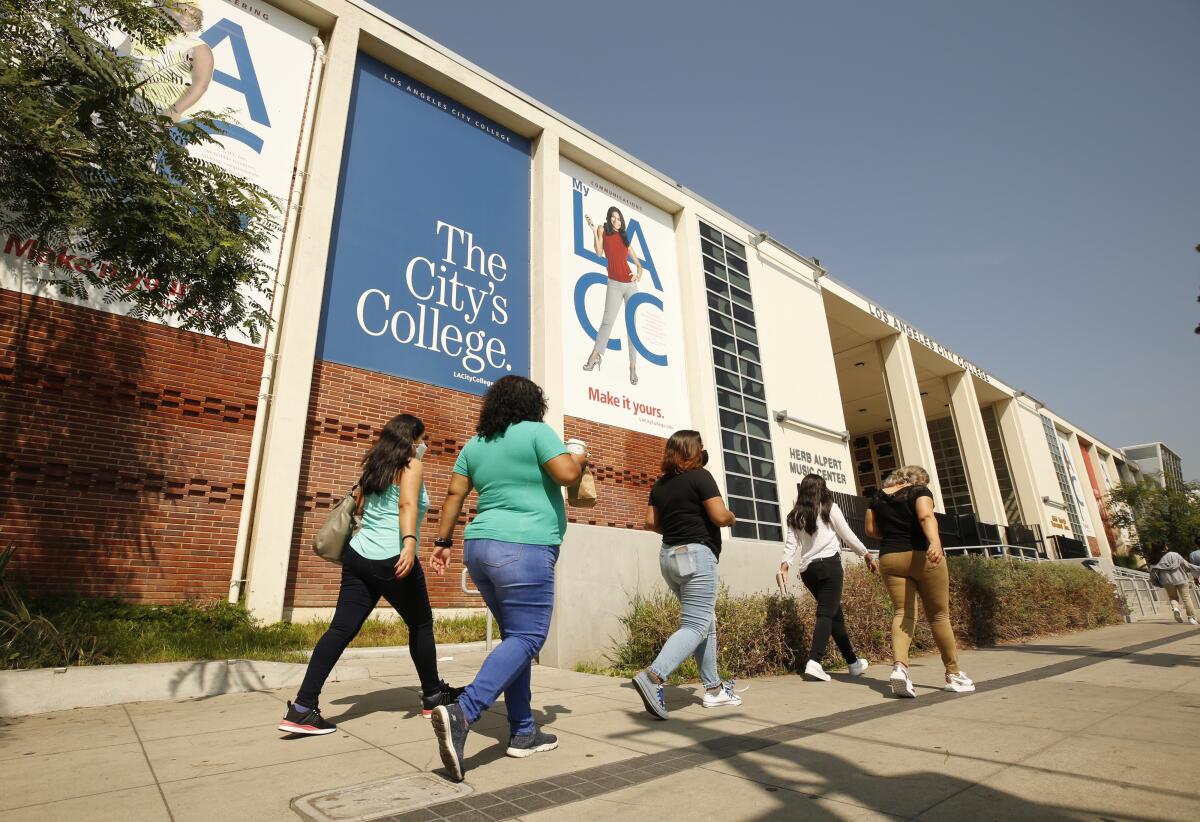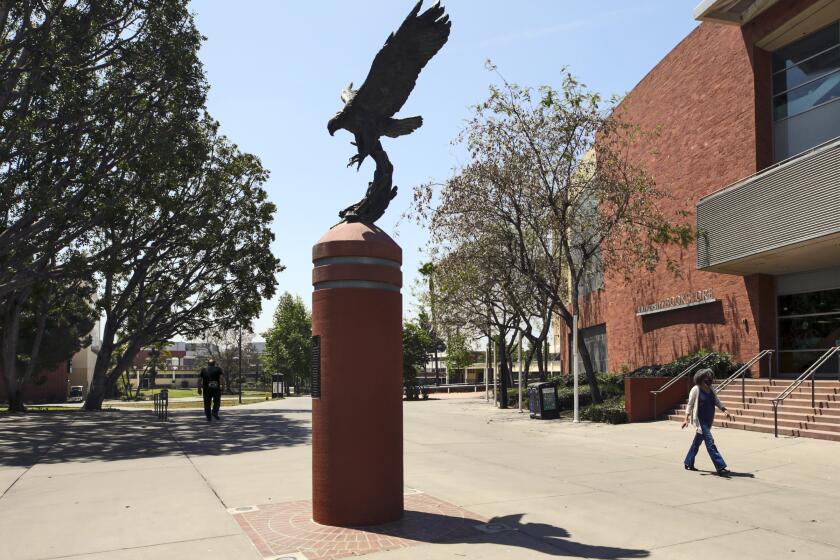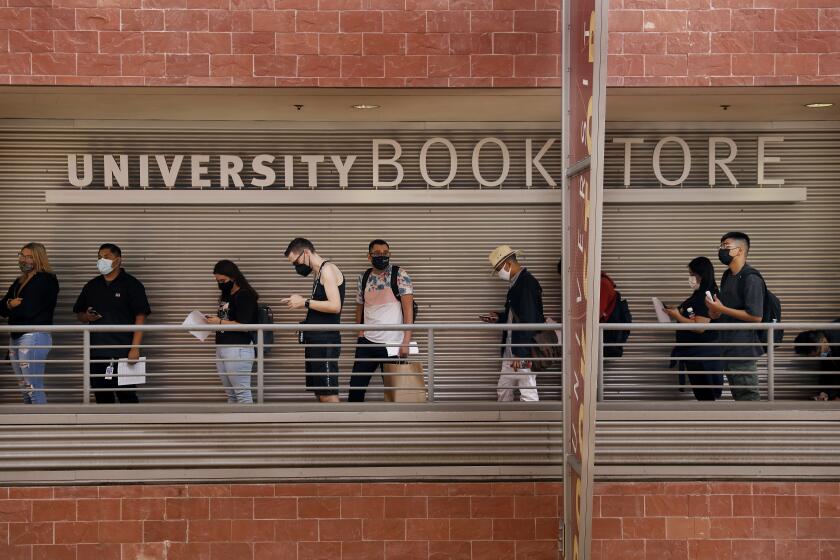Can ‘pass/no pass’ grading stem huge declines in California Community College enrollment?

- Share via
Last spring, Josh Potgieter faced a severe mental health crisis. The San Diego community college student had taken on extra work to pay rent. The additional responsibility combined with the stress of college applications and the weight of the pandemic, exacerbated his anxiety and depression.
It took an emotional toll. He worried about his biology class — a mandatory class he needed to take in order to transfer to a university. Biology wasn’t his strong suit and he feared that a low grade could tank his grade-point average, potentially jeopardizing his dream of attending a competitive four-year university. But if he dropped the class, he would lose the financial aid he needed to stay in school. He opted instead for a “pass/no pass” mark — earning credit for the class without affecting his GPA or aid.
“It was one less thing I had to worry about,” said Potgieter, 20, who is now a political science major at UC Berkeley.
At a time of plummeting enrollment at California Community Colleges — brought on in part by pandemic hardships that forced students to get a job instead of an education — the system has moved to permanently adopt a more forgiving pass/no pass grading system — a transcript lifeline of sorts designed to prevent students from dropping out.
Students will have until the last day of instruction before finals to decide whether they want a letter grade or a pass/no pass credit to protect their GPA. In addition, they can opt for an “excused withdrawal” for coronavirus-related hardships to avoid a transcript penalty.
But the generous timeline and grade options, approved last week by the Board of Governors, comes with considerable risk to the transfer process at universities, including many in the University of California and California State University systems, which require letter grades in core subjects.
The California Community Colleges and student advocates say that careful attention by academic counselors and students can address this issue. They believe greater flexibility in utilizing the options, which were enacted as an emergency measure in 2020 when the pandemic forced campus closures, are necessary nearly two years later to keep students enrolled — especially those from underserved populations who have been disproportionately affected by the pandemic.
The grading decision is yet another example of how the pandemic has permanently altered the way community colleges are addressing student needs. Shifts once considered temporary, including more online class options and offering basic needs grants, have become necessary to keep pressured students pursing higher education.
“This is a testament that this is our new normal. We need to embrace it, and we need to learn from it,” said Marty Alvarado, California Community Colleges executive vice chancellor for educational services.
Trustees of California State University agreed with a report saying the standardized tests are less effective than high school grades in predicting college success.
Potgieter, who grew up in the foster care system, knows firsthand how the burden of financial stress was a big obstacle when trying to stay in community college.
“Anxiety and depression affect people who come from low-income backgrounds at higher levels, compared to people that come from middle class and upper class, and people in community colleges are more likely to be lower income and need more resources,” said Potgieter.
The Campaign for College Opportunity believes flexibility is key.
“We know that when a college student steps out, they often drop out never to return. That could be the determining factor in what they pursue in terms of their career and life path,” said Jessie Ryan, the organization’s executive vice president.
Colleges have increased efforts to recruit new students and reconnect with those who have left. Efforts within the Los Angeles Community College District, shared during a Board of Trustees meeting this week, include billboard advertisements and radio spots promoting Los Angeles Harbor College. At Los Angeles Trade Tech College, attempts to reach 12,000 students who have not returned to school are underway.
“Anything we can do to remove barriers once they’re in, I think is our responsibility to do so,” Ryan said.
Greater ability to choose to take a pass/no pass or an excused withdrawal, which is recorded on a transcript as a dropped class due to an extenuating circumstance, is generally viewed as a helpful tool, advocates say.
But students with dreams of a bachelor’s degree will have to be cautious in their grade decisions as there are no uniform polices among universities to guide decisions.
The budget proposal released Monday makes a significant pledge to UC and CSU: the promise of long-sought financial stability.
“There’s 100 private universities in California alone, 23 CSUs and the nine UCs. Unless there was a standardized understanding of how these pass/no pass grades will be accepted or processed at these schools, I think we have to be very careful about how we disseminate the information,” said Armando Duran, Pasadena City College dean of counseling and student services.
PCC enrollment and counseling experts said students are advised not to use the option for major requirements and are told to talk with counselors and connect with admissions officers at each of the universities they’re interested in to ensure their grade decisions will not hurt acceptance chances. For general education classes and electives, having more time to choose their grade option gives students the opportunity to make an informed decision.
“If a student ends up with an ‘A’ in the class, great — that’s improving their GPA and there’s no need for them to consider a pass/no pass,” said PCC counselor Sharis Azar. “But if they’re getting a lower grade than they were anticipating — they were hoping for something higher — now they have the option to consider, and they have all semester to get in contact with someone to talk to them about the decision.”
At Cal State, the so-called Golden Four courses — written communication, oral communication, critical thinking and mathematics — would not be eligible nor would some prerequisite classes needed to register for upper-division classes. Challenges could also arise when it comes to graduate and post-baccalaureate programs “that often consider specific courses and the grades to determine if a student is eligible for admission into their program,” said Andrew Wright, Cal State Long Beach director of admissions.
At UCLA, “pass” was accepted as a credit for winter, spring and 2020 courses because of the pandemic. From fall 2020 onward, that grading option has not been granted for major preparation courses.
“Courses that are not for major preparation and are being taken to satisfy general education requirements and/or to meet the transfer unit requirements may be taken for a pass grade. We will accept pass grades in English and math courses, but prefer letter grades in those courses, as well,” said Gary Clark, UCLA director of enrollment management.
Requirements are meant to ensure that students are well-prepared for their major when they transfer into the system.
“We require some of the major screening for about 35 different majors because that’s going to really set them up to save them time and money once they get onto our campus — the more prepared they are coming in,” said UC Santa Cruz Associate Vice Chancellor Michelle Whittingham.
The $60-million program aims to support students from low-income backgrounds who want to volunteer.
A state community college analysis showed that while the excused withdrawal option increased during the pandemic, pass/no pass has not been widely used. One reason may be due to a lack of awareness.
“If the students had a death in their family, they would go ahead and drop the class as it is the standard practice,” said Iulia Tarasova, the system’s student trustee during the board meeting. “Students would not be proactive,” she said, unless they have a strong connection with a counselor or professor.
Alvarado hopes that changes. College officials said a better communication strategy is part of the plan to ensure that students understand their options.
“These permanent changes will allow students to at least have some stability in their academic performance,” said Gerardo Chavez, Student Senate president for California Community Colleges and a student at Riverside City College.
Chavez, 23, said the pandemic has taken a toll on students who have often become the main providers for families hit by the virus, delaying their academics for the workforce.
“Especially for students coming from a working-class background, it’s really hard for them to fully dedicate themselves to their education when there’s the question of who’s bringing bread to the table,” he said.
Having more time to decide whether to opt for pass/no pass or ask for an excused withdrawal could make a huge difference for students whose priorities have shifted, he said.
For Potgieter, the option made all the difference for peace of mind in his biology class, which was not a required course for his political science major.
“If I had not been allowed to opt for a pass/no pass grading option, the added stress would have exacerbated my disabilities,” he said. “I fear that the added pressure, combined with the scarce mental health and disability resources at my community college, may have prevented me from passing my courses and transferring to UC Berkeley.”
More to Read
Sign up for Essential California
The most important California stories and recommendations in your inbox every morning.
You may occasionally receive promotional content from the Los Angeles Times.














